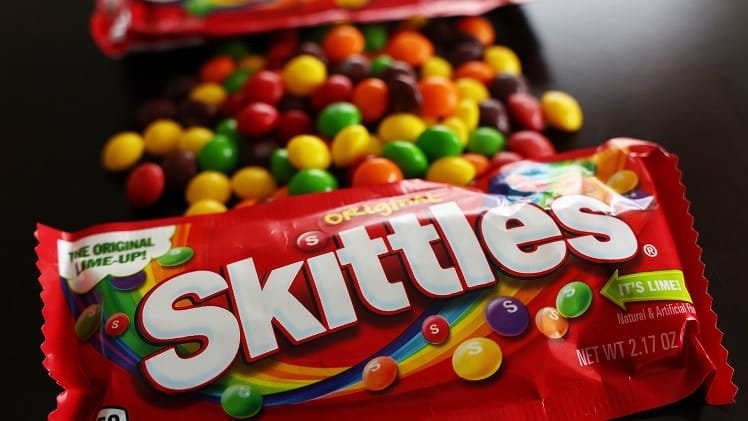Skittles Banned in California: What You Need to Know

You walk into your local store, eager to grab a pack of your favorite Skittles, only to discover they’ve been banned in California. Yes, the candy that brings a rainbow of flavors to millions of people is now at the heart of a significant legal and public health debate. But what could cause California to ban such a beloved treat? It all boils down to what’s inside the candy—specifically, certain chemicals that could pose potential health risks.
Skittles Banned in California isn’t just about one candy. It represents a much larger movement aimed at regulating potentially harmful ingredients in the food we consume every day. Whether you’re concerned about food safety or curious about how this could impact your favorite snacks, you need to know why California decided to ban Skittles and what this means for the future of food in the U.S.
Why Did California Ban Skittles?
The Skittles ban stems from California’s decision to tighten regulations on several food additives commonly used in processed foods. One of the main ingredients that prompted the ban is titanium dioxide, a food additive that gives Skittles their bright, eye-catching colors. Titanium dioxide is under scrutiny for its potential links to cancer and other health risks. California’s action is part of the larger California Food Safety Act, which bans five additives, including ones found in everyday products like candies, baked goods, and beverages.
A Breakdown of Additives Leading to the Ban
| Additive | Purpose in Foods | Health Concerns |
| Titanium Dioxide | Used to enhance colors in candies like Skittles | Linked to cancer in animal studies |
| Red Dye No. 3 | Adds vibrant red color to candies and snacks | Associated with hyperactivity in children |
| Brominated Vegetable Oil | An emulsifier found in sodas and citrus drinks | Can cause neurological issues |
| Potassium Bromate | Helps improve the texture of baked goods | Considered carcinogenic by some studies |
| Propyl Paraben | Used as a preservative in snacks and baked goods | Known endocrine disruptor affecting hormones |
These additives have long been used in various food products, but recent research and public concern have pushed lawmakers to reconsider their safety, particularly in products frequently consumed by children.
What Other Products Are Affected by the California Food Safety Act?
While Skittles has become the face of this controversy, it is far from the only product impacted by California’s new legislation. The California Food Safety Act doesn’t target one company or product—it applies to a broad range of processed foods containing the banned additives. This has sparked debates across the food industry as manufacturers and retailers scramble to adapt to these new regulations.
Foods and Additives Affected by the New Law
| Food Category | Examples of Products Impacted | Banned Additives |
| Candies and Sweets | Skittles, M&M’s, Starburst | Titanium Dioxide, Red Dye No. 3 |
| Baked Goods | Bread, pastries, cookies | Potassium Bromate |
| Snack Foods | Chips, popcorn, flavored snacks | Propyl Paraben |
| Beverages | Soda, sports drinks, citrus-flavored drinks | Brominated Vegetable Oil |
| Packaged Foods | Frozen dinners, instant noodles, packaged meals | Multiple banned additives |
The implications go beyond just one brand or food category—this law could reshape the entire processed food industry, at least within California. Manufacturers are now faced with the choice of reformulating their products to comply with the ban or ceasing sales in the state altogether.
What Will This Mean for Consumers and Businesses?
The Skittles ban might seem shocking to consumers, but it’s part of a larger effort to improve public health. California’s decision to prohibit certain additives reflects a growing trend of stricter food safety standards, which could ultimately lead to healthier options on grocery store shelves.
However, the ban poses significant challenges for businesses. Food manufacturers, particularly those that produce snacks, candies, and beverages, may need to reformulate their products to comply with the new law. This could involve finding safer alternatives for the banned additives, which may come with higher costs and production challenges.
Impact on Different Stakeholders
| Stakeholder | Effect of the Ban | Potential Action |
| Food Manufacturers | Will need to reformulate products to meet new laws | Invest in alternative ingredients |
| Retailers | May need to change inventory or remove certain items | Stock products compliant with new standards |
| Restaurants | Could face challenges in sourcing compliant ingredients | Adjust recipes and menu items |
| Consumers | May see higher prices or fewer product options | Choose healthier, chemical-free alternatives |
Consumers could also see an uptick in food prices as manufacturers pass the cost of reformulation down the supply chain. On the other hand, the Skittles ban and similar actions might encourage consumers to be more mindful of the ingredients in their food, leading to more demand for products made with natural, non-toxic ingredients.
What’s the Future for Skittles and Other Candy Brands?
Skittles isn’t the only candy that could be impacted by California’s push for safer food ingredients. Many other popular candies and processed snacks use synthetic dyes and preservatives that may not meet the new safety requirements.
One key challenge for candy makers like Mars, the company behind Skittles, is how to maintain the vibrant colors and flavors that consumers love without using these banned ingredients. Switching to natural alternatives could change the appearance and taste of products in ways that may not sit well with consumers.
Possible Natural Alternatives to Banned Ingredients
- Natural Colorants: Candy companies could switch to natural dyes like beet juice, spirulina, and turmeric, which are safer but may produce less vibrant colors.
- Natural Emulsifiers: Plant-based emulsifiers can replace brominated vegetable oil, though they may affect the texture and stability of certain products.
- Organic Preservatives: Preservatives like rosemary extract and ascorbic acid could be used instead of propyl paraben to extend shelf life without health risks.
However, reformulating candy and other processed foods is not simple. Natural ingredients can be more expensive, less consistent in quality, and harder to source. This could mean higher production costs for manufacturers, leading to increased consumer prices.
Could This Lead to a Nationwide Change in Food Safety Laws?
California has often been at the forefront of progressive regulations, and many experts believe that the Skittles ban could inspire other states to adopt similar measures. Food safety advocates hope that this action will lead to a ripple effect across the country, pushing the FDA and lawmakers in other states to reconsider their regulations on food additives.
While not all states approach food safety the same way, several are likely to follow California’s lead. States like New York, Washington, and Vermont are known for their stringent food labeling laws and could soon consider similar bans on harmful additives.
States Likely to Follow California’s Lead
| State | Reputation for Food Safety and Health Legislation | Likelihood of Introducing Similar Bans |
| New York | Progressive food safety and health policies | High |
| Washington | Emphasis on environmental and public health issues | Moderate |
| Oregon | Focused on healthy living and natural foods | High |
| Vermont | Known for strict food-labeling laws | High |
| Massachusetts | Progressive health and safety regulations | Moderate |
If more states adopt similar bans, it could prompt national food manufacturers to reformulate their products across the country rather than making separate batches for different states. This would raise food safety standards and reduce the use of potentially harmful chemicals in processed foods.
FAQs on Skittles Banned in California
Q: What caused the ban on Skittles in California?
A: The ban was primarily due to the use of titanium dioxide, a food additive linked to potential health risks such as cancer. California’s new law prohibits several additives in processed foods, including those found in Skittles.
Q: Are Skittles completely banned across the U.S.?
A: No, Skittles are currently only banned in California. However, other states may consider similar regulations in the future.
Q: Will Skittles be reformulated to comply with the ban?
A: It’s likely that manufacturers will reformulate Skittles to meet California’s new food safety standards by removing the banned ingredients or using natural alternatives.
Q: Does the Skittles ban affect other foods besides candy?
A: Yes, the California Food Safety Act affects a wide range of processed foods, including baked goods, snacks, and beverages that contain the banned additives.
Q: Could other states follow California and ban Skittles, too?
A: Other states with strong food safety laws could introduce similar bans, which might lead to nationwide changes in food regulations.
Wrapping Up
The Skittles Banned in California is a wake-up call for consumers, manufacturers, and lawmakers alike. It spotlights the hidden chemicals in many processed foods and the potential health risks associated with them. California’s actions could signal the beginning of a broader movement toward stricter food safety regulations within the state and across the entire country.
As food manufacturers look for safer alternatives to banned ingredients, we may see more products on store shelves that use natural colors, flavors, and preservatives. Although this could lead to higher prices or changes in the taste and appearance of some foods, it’s a move toward greater transparency and healthier food choices. Whether you’re a fan of Skittles or not, this ban represents a shift in how we think about our food and the ingredients we allow in our bodies.




